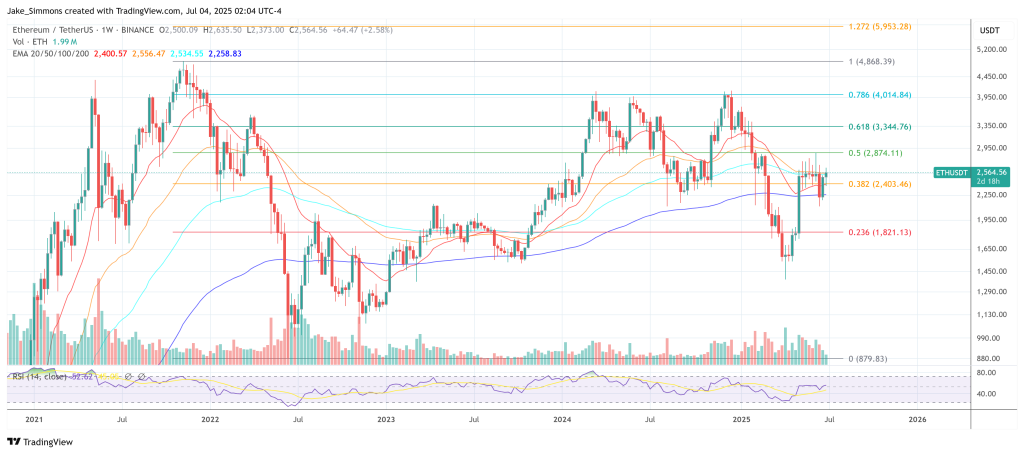🚀 Ethereum’s Insane $706K Price Target—New Research Sparks Crypto Frenzy
Brace for impact—Ethereum just got its most audacious price prediction yet.
### The $706,000 ETH Thesis: Greed or Genius?
Analysts are either visionary or delusional with this call—either way, it's shaking crypto Twitter. The report bypasses moonboy hype, anchoring its case in adoption metrics that'd make even Bitcoin maximalists blink.
### Why This Isn't Your Average Price Pump
Forget meme coins and leveraged degens. This forecast assumes Ethereum becomes the backbone of global finance—while Wall Street still charges 2% fees for moving paper bonds.
### The Fine Print Nobody Wants to Read
Yes, it'd require ETH flipping gold's market cap. No, your NFT portfolio won't help. The real question: Will institutions FOMO in before retail gets liquidated—again?
Framing Ethereum Against Traditional Stores Of Value
To reach the headline valuation, the study compares Ethereum’s native asset with four established reservoirs of value: proven crude-oil reserves (~ $85 trillion), Gold (~ $22 trillion), the global bond market (~ $141 trillion) and worldwide broad money supply, M2 (~ $93 trillion). averaging those four benchmarks yields an indicative “long-term potential” of $85 trillion for ETH’s aggregate valuation, or roughly $706,000 per coin.
The authors emphasise that this figure is not a price target on a timetable but rather an end-state equilibrium if Ethereum succeeds in acting simultaneously as energy commodity, monetary metal, sovereign-grade collateral and base-layer money for a digital economy.
Crucial to their thesis is Ethereum’s monetary design. Gross issuance tops out at 1.51 percent of supply per year, while roughly 80 percent of transaction fees are destroyed, driving net issuance toward deflation as on-chain activity rises.
Since the September 2022 merge to proof-of-stake, the study notes, effective supply growth has hovered NEAR 0.09 percent—lower than both fiat money and Bitcoin. The report frames this programme as “predictable scarcity” that contrasts with Bitcoin’s hard-cap model, which the authors argue may eventually under-incentivise miners and weaken Bitcoin’s security budget.
Another pillar is staking yield: validators earn base issuance plus a share of fees for securing the chain, making staked ETH “a productive, yield-bearing digital commodity.” The paper likens that yield to gold-lending revenue or oil-reserve leasing, but emphasises that, unlike those physical commodities, ETH’s yield is natively programmable and automatically compounding.
Roughly 32.6 percent of the current ETH supply already serves as collateral in DeFi or enterprise infrastructure, while an additional 3.5 percent has migrated to other blockchains. As tokenized real-world assets proliferate, the authors foresee rising demand for a “globally neutral, censorship-resistant reserve asset” within settlement protocols—an economic role they argue only ETH can fill without external counterparty risk.
Near-Term And Medium-Term Milestones For ETH
While the ultimate scenario envisions a six-figure ETH, the study outlines interim milestones: a “short-term” price of $8,000 (~US $1 trillion market cap) and a “medium-term” level of $80,000 (~US $10 trillion). Four catalysts are identified: First, the rapid tokenization of real-world assets and institutional on-chain infrastructure. Second is the institutional appetite for native staking yield, especially once staked-ETH exchange-traded funds come to market.
The third argument is the “race to stockpile ETH,” evidenced by an embryonic strategic-reserve pool that already counts nearly US $2 billion in publicly disclosed holdings. Moreover, the authors predict growing use of ETH in treasury management, where its neutrality, programmability and yield allow automated collateral, escrows and payments.
“ETH stands alone as the neutral reserve asset uniquely positioned to secure and power the global tokenized financial system,” the authors write, characterising the current market price as “a temporary mispricing, not a structural weakness.”
However, the report’s authors also concede that Ethereum’s complexity makes valuation “more challenging” than Bitcoin’s simpler digital-gold narrative. They also warn that ETH cannot be modelled like a technology equity: discounted-cash-flow methods capture neither ETH’s commodity burn nor its role as base-layer collateral.
Nevertheless, they argue that multipronged utility—fuel, store of value, collateral and yield—creates an upside “which could even surpass Bitcoin’s.” In their words, ETH is “an entirely new category of asset,” requiring comparables drawn from energy, monetary metals, sovereign bonds and global money supplies rather than from fee-generating software platforms.
At press time, ETH traded at $2,564.


